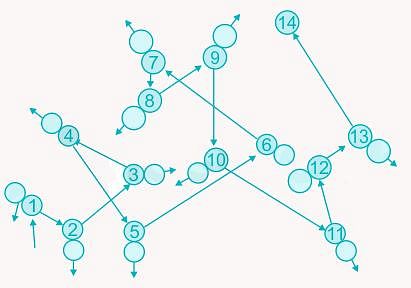Chemistry Exam > Chemistry Questions > The continuous zig-zag movement of colloidal ...
Start Learning for Free
The continuous zig-zag movement of colloidal particles in a dispersion medium is called
- a)Dispersion
- b)Tyndall effect
- c)Brownian movement
- d)Oscillation
Correct answer is option 'C'. Can you explain this answer?
| FREE This question is part of | Download PDF Attempt this Test |
Verified Answer
The continuous zig-zag movement of colloidal particles in a dispersion...
Brownian movement:
- Sometimes, when the beam of sunlight enters a room, we can see tiny dust particles suspended in the air which is moving rapidly.
- The tiny dust particles move here and there because they are constantly hit by the fast-moving particles of air.
- The zig-zag movement of the small particles suspended in a liquid (or gas) is called Brownian motion.

- The existence of Brownian motion gives us two conclusions about the nature of matter :
- That matter is made up of tiny particles, and
- That the particles of matter are constantly moving.
- The best evidence for the existence and movement of particles in liquids was given by Robert Brown in 1827.
Hence, the continuous zig-zag movement of colloidal particles in a dispersion medium is called Brownian Motion.
So, the correct option is the Brownian movement.

|
Explore Courses for Chemistry exam
|

|
The continuous zig-zag movement of colloidal particles in a dispersion medium is calleda)Dispersionb)Tyndall effectc)Brownian movementd)OscillationCorrect answer is option 'C'. Can you explain this answer?
Question Description
The continuous zig-zag movement of colloidal particles in a dispersion medium is calleda)Dispersionb)Tyndall effectc)Brownian movementd)OscillationCorrect answer is option 'C'. Can you explain this answer? for Chemistry 2024 is part of Chemistry preparation. The Question and answers have been prepared according to the Chemistry exam syllabus. Information about The continuous zig-zag movement of colloidal particles in a dispersion medium is calleda)Dispersionb)Tyndall effectc)Brownian movementd)OscillationCorrect answer is option 'C'. Can you explain this answer? covers all topics & solutions for Chemistry 2024 Exam. Find important definitions, questions, meanings, examples, exercises and tests below for The continuous zig-zag movement of colloidal particles in a dispersion medium is calleda)Dispersionb)Tyndall effectc)Brownian movementd)OscillationCorrect answer is option 'C'. Can you explain this answer?.
The continuous zig-zag movement of colloidal particles in a dispersion medium is calleda)Dispersionb)Tyndall effectc)Brownian movementd)OscillationCorrect answer is option 'C'. Can you explain this answer? for Chemistry 2024 is part of Chemistry preparation. The Question and answers have been prepared according to the Chemistry exam syllabus. Information about The continuous zig-zag movement of colloidal particles in a dispersion medium is calleda)Dispersionb)Tyndall effectc)Brownian movementd)OscillationCorrect answer is option 'C'. Can you explain this answer? covers all topics & solutions for Chemistry 2024 Exam. Find important definitions, questions, meanings, examples, exercises and tests below for The continuous zig-zag movement of colloidal particles in a dispersion medium is calleda)Dispersionb)Tyndall effectc)Brownian movementd)OscillationCorrect answer is option 'C'. Can you explain this answer?.
Solutions for The continuous zig-zag movement of colloidal particles in a dispersion medium is calleda)Dispersionb)Tyndall effectc)Brownian movementd)OscillationCorrect answer is option 'C'. Can you explain this answer? in English & in Hindi are available as part of our courses for Chemistry.
Download more important topics, notes, lectures and mock test series for Chemistry Exam by signing up for free.
Here you can find the meaning of The continuous zig-zag movement of colloidal particles in a dispersion medium is calleda)Dispersionb)Tyndall effectc)Brownian movementd)OscillationCorrect answer is option 'C'. Can you explain this answer? defined & explained in the simplest way possible. Besides giving the explanation of
The continuous zig-zag movement of colloidal particles in a dispersion medium is calleda)Dispersionb)Tyndall effectc)Brownian movementd)OscillationCorrect answer is option 'C'. Can you explain this answer?, a detailed solution for The continuous zig-zag movement of colloidal particles in a dispersion medium is calleda)Dispersionb)Tyndall effectc)Brownian movementd)OscillationCorrect answer is option 'C'. Can you explain this answer? has been provided alongside types of The continuous zig-zag movement of colloidal particles in a dispersion medium is calleda)Dispersionb)Tyndall effectc)Brownian movementd)OscillationCorrect answer is option 'C'. Can you explain this answer? theory, EduRev gives you an
ample number of questions to practice The continuous zig-zag movement of colloidal particles in a dispersion medium is calleda)Dispersionb)Tyndall effectc)Brownian movementd)OscillationCorrect answer is option 'C'. Can you explain this answer? tests, examples and also practice Chemistry tests.

|
Explore Courses for Chemistry exam
|

|
Suggested Free Tests
Signup for Free!
Signup to see your scores go up within 7 days! Learn & Practice with 1000+ FREE Notes, Videos & Tests.
















